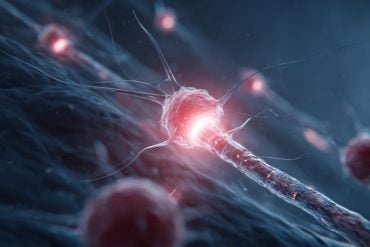Summary: People who experienced language and communication difficulties as a result of psychosis showed weaker connectivity in the superior temporal area, an area of the brain associated with language processing. Those with greater language problems had greater connectivity in other areas of the brain, suggesting the brain may utilize other areas to compensate for language in patients with psychosis.
Source: University of Western Ontario
Just as a small airport would have challenges handling massive plane traffic, people with psychosis may experience communication difficulties because non-language parts of the brain are trying to manage communications tasks, new research from Western and Lawson Health Research Institute shows.
Difficulties with communication – the ability to use language and to comprehend what others are saying – are among the earliest symptoms of psychosis, a mental illness characterized by changes in emotions, impaired functioning and a disconnection from reality.
This could be happening because parts of the brain not meant to process language are trying to perform this complex job, the new research shows.
“The language system seems to be key to understanding this illness,” said Dr. Lena Palaniyappan, professor and Tanna Schulich Chair in Neuroscience and Mental Health at Western’s Schulich School of Medicine & Dentistry and scientist at Lawson and Robarts Research Institute. “We don’t yet fully understand how the disorganization of language takes place in patients affected by psychosis.”
Embarking on a mission to find out, Dr. Palaniyappan worked with a team of imaging scientists at Robarts to perform magnetic resonance imaging (MRI) scans on the brains of patients with acute psychosis. Patients were recruited from the Prevention and Early Intervention Program for Psychoses (PEPP) at London Health Sciences Centre, a flagship clinic that supports young individuals from an early stage of psychosis.
The team divided the patients into two groups: those with severe language disturbances, and those whose language symptoms were less pronounced. They found that both groups had weakened connectivity, or ‘hubness,’ in the superior temporal area, the part of the brain generally associated with language.
The group with more severe language symptoms also greater connectivity in unexpected regions of the brain that seemed to be compensating for some of the loss of connectivity elsewhere.
Like a small airport trying to handle all the air traffic from a big hub like Pearson International Airport, some non-language brain regions may be overloaded in psychosis, the study says.
“This finding led us to believe that the language problems may occur because the main hubs that are supposed to conduct language are now retired, and so these peripheral hubs – which have no business of orchestrating language as their main function – are picking up the job and aren’t doing it very well,” said Palaniyappan.
The researchers hope that this new understanding of how language becomes disorganized in psychosis can inform new interventions to focus on strengthening the language systems in the brain to reduce or delay psychotic symptoms.

Using ultra-high-field magnetic resonance imaging at Robarts, they were able to look at the entire brain of patients with acute psychosis. Instead of homing in on one specific area, the team looked at 3-D pixels of the brain (voxels) to get a full picture of what was happening in the whole brain and how different areas were interacting.
Continuing the airport analogy, Palaniyappan said that if they had looked only at the brain’s language area it would have been like only walking into one airport, and not understanding how the reduced traffic in that airport was influencing air traffic at other surrounding airports.
“We went in without any expectations, and searched the whole brain,” said Dr. Palaniyappan. “This unique approach allowed us to get a picture of the forest rather than a picture of the tree.”
The study is the first to use this kind of imaging study in patients with acute psychosis who had a wide variety and severity of clinical symptoms.
“Because of the uniqueness of this patient group, we made sure ample time was given to explain the procedure and what was expected,” said Joe Gati, acting director of the Western Centre for Functional and Metabolic Mapping at Robarts.
“The protocol was kept brief and communication with the subject was maintained throughout the procedure. We also ensured that the imaging protocol was optimized to prioritize data collection, keep noise levels as low as possible, and to minimize the amount of time research subjects were required to be in the MRI.”
Funding: The study was funded through an early-career foundation grant from the Canadian Institutes of Health Research and was supported by PEPP.
About this language and psychosis research news
Source: University of Western Ontario
Contact: Crystal Mackay – University of Western Ontario
Image: The image is in the public domain
Original Research: Open access.
“Conceptual disorganization and redistribution of resting-state cortical hubs in untreated first-episode psychosis: A 7T study” by Avyarthana Dey, Kara Dempster, Michael MacKinley, Peter Jeon, Tushar Das, Ali Khan, Joe Gati & Lena Palaniyappan. npj Schizophrenia
Abstract
Conceptual disorganization and redistribution of resting-state cortical hubs in untreated first-episode psychosis: A 7T study
Network-level dysconnectivity has been studied in positive and negative symptoms of schizophrenia. Conceptual disorganization (CD) is a symptom subtype that predicts impaired real-world functioning in psychosis. Systematic reviews have reported aberrant connectivity in formal thought disorder, a construct related to CD. However, no studies have investigated whole-brain functional correlates of CD in psychosis.
We sought to investigate brain regions explaining the severity of CD in patients with first-episode psychosis (FEPs) compared with healthy controls (HCs). We computed whole-brain binarized degree centrality maps of 31 FEPs, 25 HCs, and characterized the patterns of network connectivity in the 2 groups. In FEPs, we related these findings to the severity of CD.
We also studied the effect of positive and negative symptoms on altered network connectivity. Compared to HCs, reduced centrality of a right superior temporal gyrus (rSTG) cluster was observed in the FEPs. In patients exhibiting high CD, increased centrality of a medial superior parietal (mSPL) cluster was observed, compared to patients exhibiting low CD. This cluster was strongly correlated with CD scores but not with other symptom scores. Our observations are congruent with previous findings of reduced but not increased centrality. We observed increased centrality of mSPL suggesting that cortical reorganization occurs to provide alternate routes for information transfer.
These findings provide insight into the underlying neural processes mediating the presentation of symptoms in untreated FEP. Longitudinal tracking of the symptom course will be useful to assess the mechanisms underlying these compensatory changes.






